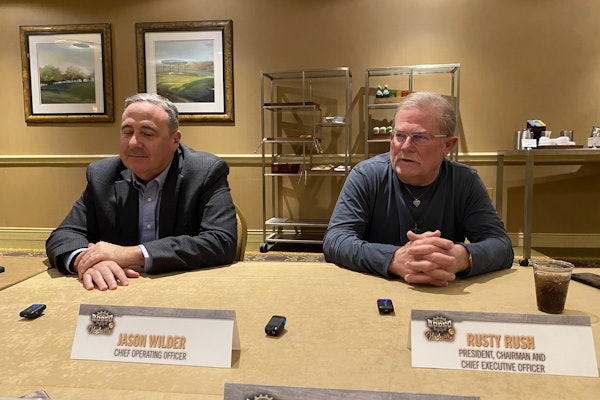By Bill Wade, Wade & Partners
Business planning season is back. For some, with a vengeance. Your company management wants to know with some certainty and in some detail:
- What will the economy look like?
- What will the heavy-duty truck end-user market look like?
- What do our competitors look like?
- What are we going to do to grow top and bottom lines?
No problem, boss, we’ll get on it right away. (Editor’s note: We can’t help you with No. 4 here.)
But there is a completely different approach used successfully by numerous industrial distributors under the tutelage of partner Bruce Merrifield. Similar to techniques in Lean exercises (current state/future state), it’s called Visionary Planning:
- Start with an ideal vision of what customers might want in 2020 and beyond.
- With that end in mind move backwards from the vision to the present.
- Then ask: “What do we do today, step by step, to move towards the vision?”
- Talk in the future perfect tense. “By 2020, Amazon will have achieved this next-level shopping experience. And, we will have accomplished…” (What:_____ to stay vital?)
Getting a vision pinned down has to be Job No. 1. Without some firm…and generally understood and agreed…guidelines, everybody can enjoy some great conversation, but no firm foundation for the plan will be available to add tactics to a strategy.
And the tactical part is getting more challenging every day. New counter-mats or illuminated clocks no longer pass for brand building. Increased price transparency puts additional pressure on real value creation from marketing dollars.
Just look at the added complexity that has surfaced since you did the 2015 plan:
- Diminished Brands: Fewer than one quarter of American consumers are brand loyal. No reason to think business-to-business will be different.
- Disordered Channels. Customers create channels, legacy participants have little say, preferences can create erosion … or earthquakes.
- Disruptive Technology: Both product technology and the science of distribution (logistics) have advanced at lightning speed.
- Disappearing People: Willy Loman has left the building. Can Alexa or Siri take up the slack? Can training using augmented/virtual reality tools train fast enough?
Back to the Boss’s Four Questions
As for No. 1: If we knew that answer, we would be guest hosting on CNBC or Bloomberg News. But here are some ‘Economy 2020’ hints in last week’s Wall Street Journal … You pick what to believe:
- The latest quarterly outlook by the National Association for Business Economists states that its panel of 45 economists believe that the nation’s gross domestic product will grow by 2.8 percent this year.
- The panelists forecasted that the nation’s GDP would grow by 2.7 percent in 2019.
- However, the NABE panel also stated that two-thirds of the economists are predicting that a recession will start by the end of 2020 and 18 percent believe that a decline could begin as soon as the end of 2019.
- Vanguard (a $5 trillion trust manager) puts the probability of a recession by late 2020 at 30 percent to 40 percent.
One of the biggest causes of a decline, three-fourths of the panelists predict that tariffs on steel and aluminum imports from the Canada, Mexico, and the European Union, as well as tariffs on Chinese parts imports, will trigger a global trade war as the nations look to retaliate.
As for No. 2: Focus still seems to be on the juice. What will power the fleet?
- 2015 was the first year where the world economy grew while carbon emissions didn’t.
- Peak oil had been estimated for 1998, but is now called for in 2020-2022
- Coal peaked in 2008, some expect natural gas to peak in 2020
- The long-awaited, oft-delayed electric car revolution is now rescheduled for 2022, with 25 percent of total vehicle market share — by 2040.
- According to CCJ (sister publication to Truck Parts & Service), freight rates are up 25-30 percent over 2017.
- FTR reports that preliminary North American Class 8 orders for July hit an all-time high of 52,250 units. Orders were up 25 percent month-over-month and 187 percent year-over-year.
- Five of the highest 12 order months ever have occurred in the first seven months of this year. North American Class 8 orders for the past twelve months have now totaled 445,000 units. Trailer orders are hot, too.
If you need tables of facts for your plan presentation — broken down by vocation, place of maintenance or who knows what else — contact MacKay & Company. They have stats to please (or confound) the pickiest management committee or board.
Question No. 3 demands some fresh thinking. Who will my competition be?
Answering this question is why they pay you the big bucks! What new parts (and/or service) sources may develop in a few years. Pick one or more:
- Import and domestic parts are offered by ‘bundlers’ who sell shops and fleets direct, mostly online, eliminating costs needed to run a branch operation.
- Mobile service operations take over most of the maintenance parts (see Dickinson Fleet Services in Indiana as a great example today).
- Industrial distributors need more SKUs to support huge branch operations (Grainger, Fastenal, Motion, HD Supply, etc.).
- Dealer consolidation creates networks with vehicle diagnostic and parts installation service in every branch and superior buying power (OEM or component suppliers).
And then there’s the Death Star (Amazon)
Amazon’s announcements and trends add up to a high-probability scenario. Consider this: Channel creation and stocking barriers don’t exist for cyber-shelf space at Amazon.
- Amazon’s value-chain platforms will all strengthen. What are the odds that Prime members, for example, will be greater in: number, loyalty and activity?
- Demographics: 50 percent of purchasing agents will be digital-native, millennials. Will they go to Amazon first for business-to-business (B2B) shopping information and spot-buy purchasing? The millennial shopping mindset will also infect many older buyers.
- 5G bandwidth phones will be getting traction. What’s possible with 10 to 100 times the download speed and pixelization of 4G speed?
- ‘Machine learning’ targeting of most promising customers for niche products will improve.
- Amazon has patented the capability to give us reward points for watching the infomercials.
- Amazon’s superior supply-chain will add more Amazon brand knockoffs of legacy channels’ most, net-profitable SKUs. Or, start-ups will do the same. Available instantly and only through Amazon.
B2B brands will be on Amazon to win the content management war against the upstart clones. But, will legacy channel partners adjust to deliver and price like Amazon alternatives?
Then there are the critical, life changing trends
The game of the American people — its most popular sport — may become something only available to those who can afford the resources to play it, much less watch it. Football (real football — not the kick around a ball in shorts version) even 20 years from now, will never, ever be completely safe.
Already, high schools face player shortages. It is becoming a regional interest (like hockey), growing only in California and the Southeast. While the surge in reporting on long-term dangers like CTE make the violent side of the game seem like the only element of the game (think NASCAR and crashes), parents are actually thinking that using clubs on each other is preferable (lacrosse and hockey).
Face it. No sport really is ever completely safe — not even golf, a sport where 54,000 people every year end up in the emergency room when they are hit by errant drives and golf carts.
Some may feel like forecasting and planning is a similar sport. That there’s no point in making predictions … someone is bound to get hurt!











